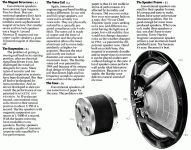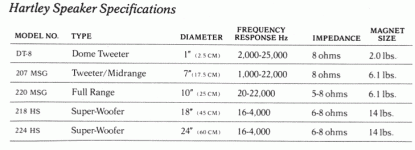sounds like dipole material..
(nice to have the mystery "unveiled".. I never would have suspected that Hartley's were still in production.)
btw, though I don't know if its accurate or not, here is post concerning price:
http://www.audioasylum.com/forums/HUG/messages/57364.html
(nice to have the mystery "unveiled".. I never would have suspected that Hartley's were still in production.)
btw, though I don't know if its accurate or not, here is post concerning price:
http://www.audioasylum.com/forums/HUG/messages/57364.html
We do not think it appropriate to post prices & specs on this site.
Why wouldn't it be appropriate? I mean, don't you want to sell products? Even if there's some reason you wouldn't want your prices posted, why wouldn't you want driver specs posted here?
No offense, but I just don't understand...

That is unfortunate.
My buying decision would have been based entirely on the evolution of this discussion, despite a rocky start.
I was hoping for some circumspection on these drivers due to the fact that the information provided to me two months ago was scanned from copy at least 35 years old, from a LaFayette catalogue, by the looks of it. Four of the files contained viruses.
This information, which presumably is forwarded to prospective buyers specifies the driver uses a 6 pound AlNiCo magnet. It was then learned in passing, in a follow up conversation -with the office administrator- that the magnet was "changed years ago." This was an interesting and timely discovery, as I was calling TO PLACE AN ORDER, you see.
Had I purchased, based on information provided me, only upon receipt six weeks later would I have learned that (arguably) the most important component of this driver was not what I had expected, and not what I had purchased. To the letter of the Law, this would have constituted Fraudulent Misrepresentation. This is not my opinion, but is based on the opinion of a friend who practices Corporation Law, whom I happened to query around that time, during a social conversation.
Despite all this, I still am intrigued by these drivers. And now this.
My buying decision would have been based entirely on the evolution of this discussion, despite a rocky start.
I was hoping for some circumspection on these drivers due to the fact that the information provided to me two months ago was scanned from copy at least 35 years old, from a LaFayette catalogue, by the looks of it. Four of the files contained viruses.
This information, which presumably is forwarded to prospective buyers specifies the driver uses a 6 pound AlNiCo magnet. It was then learned in passing, in a follow up conversation -with the office administrator- that the magnet was "changed years ago." This was an interesting and timely discovery, as I was calling TO PLACE AN ORDER, you see.
Had I purchased, based on information provided me, only upon receipt six weeks later would I have learned that (arguably) the most important component of this driver was not what I had expected, and not what I had purchased. To the letter of the Law, this would have constituted Fraudulent Misrepresentation. This is not my opinion, but is based on the opinion of a friend who practices Corporation Law, whom I happened to query around that time, during a social conversation.
Despite all this, I still am intrigued by these drivers. And now this.
I am sorry if there has been a misunderstanding -
When anybody writes to us, looking for info on our drivers, we
send out a spec sheet, showing the drivers we have been
making, but we include an alteration of the magnet assembly,
which we call "EFM". This was a major innovation in magnet
design we made in 1980. It was a significant improvement in
performance and a lowering of amplitude distortion. All that have
used these current drivers have the same conclusion. The photo
on this spec sheet does show the older Alnico magnet and we
are sorry for that confusion.
I have only entered this forum to correct some product and historical errors.
I think it would be more appropriate for any members to contact me directly for specs and prices.
I did not want the forum to think we are in this for sales reasons. I welcome any direct e-mails.
When anybody writes to us, looking for info on our drivers, we
send out a spec sheet, showing the drivers we have been
making, but we include an alteration of the magnet assembly,
which we call "EFM". This was a major innovation in magnet
design we made in 1980. It was a significant improvement in
performance and a lowering of amplitude distortion. All that have
used these current drivers have the same conclusion. The photo
on this spec sheet does show the older Alnico magnet and we
are sorry for that confusion.
I have only entered this forum to correct some product and historical errors.
I think it would be more appropriate for any members to contact me directly for specs and prices.
I did not want the forum to think we are in this for sales reasons. I welcome any direct e-mails.
R,
No apologies owed here; just that there is considerable interest in your offering on these threads, and a level of frustration over the apparent lack of easy-access 'net-information, like we all have become very used to, that we can discuss.
My recounting was merely to illustrate what can happen when things go wrong in the business world. Personally, I was delighted to find that these musical gemstones were actually still around, as I too thought they had vanished into the mists of time. For that, I think you can be commended actually. I am hoping to be able to see my way to a working solution using the 220MSG, through the always enlightening discourse of the members.
No apologies owed here; just that there is considerable interest in your offering on these threads, and a level of frustration over the apparent lack of easy-access 'net-information, like we all have become very used to, that we can discuss.
My recounting was merely to illustrate what can happen when things go wrong in the business world. Personally, I was delighted to find that these musical gemstones were actually still around, as I too thought they had vanished into the mists of time. For that, I think you can be commended actually. I am hoping to be able to see my way to a working solution using the 220MSG, through the always enlightening discourse of the members.
Re: hartley
ditto
tomtt said:would sill like to see more pics
and hear some history?
ditto
audiolab said:I think it would be more appropriate for any members to contact me directly for specs and prices.
I did not want the forum to think we are in this for sales reasons. I welcome any direct e-mails.
And so it happened.
Hartley:
http://home.student.utwente.nl/n.f.l.vanderlinden/hartley.zip
"Prices do not include freight. Most of our international customers preview Global Express via the post office."
Hartley:
220MSG:
Cabinet designs would be:
* Closed box - 6 - 8 cubic feet.
* Transmission line - obtained from old issues of SPEAKER BUILDER magazine.
* Special vented box - our design. Will supply parameters when speakers are purchased.
Q:
What is the balance like when you use a single 220MSG in, for instance, the special vented box design. I really dislike passive filters in my speakers (especially for the wide-range section). However, you do seem to provide bass units and tweeters and passive crossovers. I have also found one three-way design on the net with non-hartley tweeter and bass. But 47 Labs, as you know, just puts a tweeter on top the 220MSG (and blends it in way high..?).
Do you have a picture of the vented design box 'in action'? A friend of mine is really keen on looks, so the dimensions should suit him. I'm myself coming from an open baffle system, but my room is small and thus placement is very critical, so I too might be interested in the vented design.
A:
The 220MSG is a fine full range speaker. Some people like adding a super tweeter for blend. 47 Labs is crossing over at 20kHz. I am enclosing a photo of the vented cabinet.
An externally hosted image should be here but it was not working when we last tested it.
============================================================================================
Internet:
An externally hosted image should be here but it was not working when we last tested it.
An externally hosted image should be here but it was not working when we last tested it.
http://www.audio-maestro.com/ma3.html
An externally hosted image should be here but it was not working when we last tested it.
http://www.audio-maestro.com/pre.html
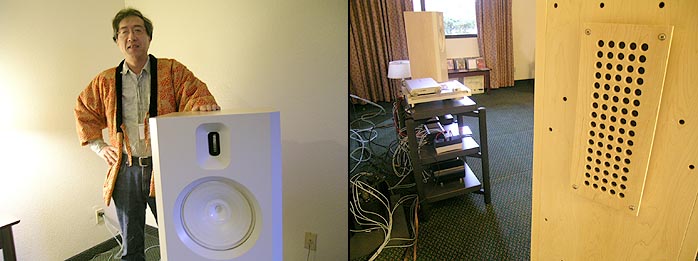
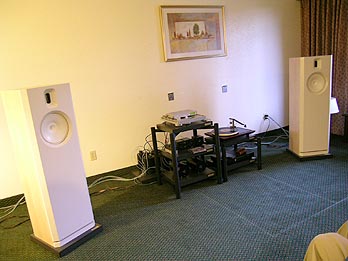
http://www.6moons.com/industryfeatures/ces05/ces_8.html
"Yoshi Segoshi of Sakura Systems debuted his Hotei speaker system [$12,000/pr] that employs a resistively-loaded white 9" polymer cone as filter-less fullrange transducer. That's mated at 20kHz to a 2.5" ribbon with a 6dB slope. 92dB sensitivity, 5-ohm nominal impedance and dimensions of 44" H x 15" W x 14.5" D complete the specs."
An externally hosted image should be here but it was not working when we last tested it.
http://archaicaudio.lunarpages.com/cd1/0207/h0001.htm
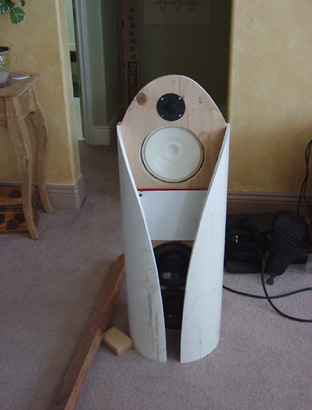
http://www.htguide.com/forum/showthread.php4?p=69689
An externally hosted image should be here but it was not working when we last tested it.
http://www.diy-systems.com/en-us/pg_46.html
An externally hosted image should be here but it was not working when we last tested it.
http://audiokarma.org/forums/showthread.php?t=1374
"My Dad and Harold Luth were friends. Harold Luth designed and built the 207MSG(7" tweeter), 220MSG(10" full range), 218MSG(18" woofer), and the 224MSG(24" woofer) for Hartley. The 220 was the first and he started making them in the early 1960's. All these drivers were hand built in Holland Michigan by Harold. He had several patents for their constructions. They all had his all-polymer speaker cone with magnetic suspension. The magnetic suspension is a band of iron particles bonded to the voice coil that provide the restoring force to return the cone back to the neutral position. This makes the speaker very fast for its size. The 207 and 220 have a dual coaxial voice coil with the inner voice coil a shorted aluminum turn driving the smaller high frequency cone. Both woofers have 14 pound Alcomax magnet structure and the 207 and 220 have 6.1 pounds magnets. All speakers have cast aluminum frames. In the 80's the English Alcomax magnets were hard to get and he switch to a same strength ceramic magnet.
The following is a picture of my home built Concertmasters. They were built in 1982 and have the 224, 220 and 207 for the drivers.
Harold helped with building the crossovers. We hand wound all the inductors. The advertised frequency for them is 16 to 22k."
I'll add David Ruether's 24" hartley TL...
An externally hosted image should be here but it was not working when we last tested it.
http://www.ferrario.com/ruether/Audio.html
dave
http://www.tobs.info/hartleyt.htm
An brief introduction to H.A. Hartley:
"H.A. Hartley was an audio engineer who started out way back in the 1920’s. In 1927 he coined the phrase High Fidelity, “to denote a type of sound reproduction that might be taken rather seriously by a music lover”. To this end he published a sires of articles outlining the goals for realistic reproduction of music. He worked with P.K. Turner to produce one of the best radio receivers of the era. At the time there were two rationales in audio reproduction. Briefly put: Camp A, said it was best to limit the frequency response of radio receivers and phonographs to cut out unpleasant hiss, crackles and whistles. Camp B said no, widen the response and deal with the consequences. As the technology improved camp B won the debate and “high fidelity” became the goal for all audio engineers.
Before WWII Hartley started work on a new speaker the 215. It featured a host of outstanding technical innovations, such as symmetrical magnetic flux, a dual VC, a decoupled inner cone to increase HF response and a suspension system which reduced the bass resonance peak. The 215 was not released commercially until after the war.
The next phase in the Hartley story involved the American engineer and chemist Harold Luth. In the 1950s Mr Luth worked with Harltey to produce 2 new innovations a polymerized cone and the rather exciting sounding magnetic suspension. Hartley Products inc. Also produced some phenomenal woofers, you may be familiar with the Harltey Decca Quad combination."
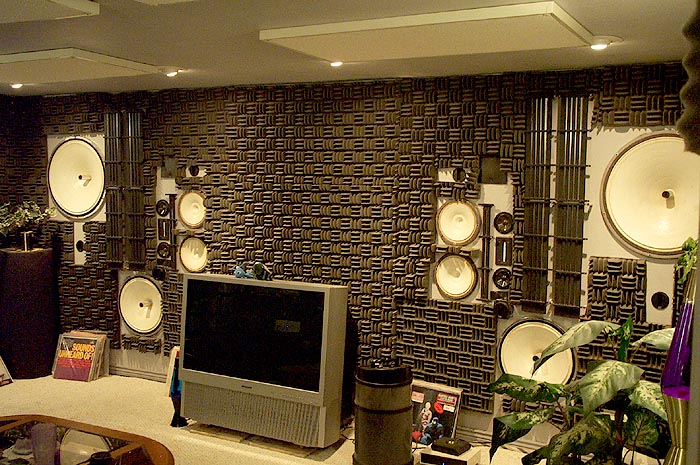
http://www.6moons.com/industryfeatures/ramsey/jerry.html
http://www.soundstagelive.com/factorytours/audiomagic/
What by the dull hammer of Thor are you staring at? Well, that's the main reason for today's interview - to shock well-seasoned audiophiles with what seems to defy all dearly-held point-source or even line-source principles. Having heard it years ago in an earlier incarnation, I knew this in-wall cluster speaker system to work amazingly well. Jerry's mo-betta claims of subsequent alterations and upgrades simply compelled me to listen again. But first, a closer look.
An brief introduction to H.A. Hartley:
"H.A. Hartley was an audio engineer who started out way back in the 1920’s. In 1927 he coined the phrase High Fidelity, “to denote a type of sound reproduction that might be taken rather seriously by a music lover”. To this end he published a sires of articles outlining the goals for realistic reproduction of music. He worked with P.K. Turner to produce one of the best radio receivers of the era. At the time there were two rationales in audio reproduction. Briefly put: Camp A, said it was best to limit the frequency response of radio receivers and phonographs to cut out unpleasant hiss, crackles and whistles. Camp B said no, widen the response and deal with the consequences. As the technology improved camp B won the debate and “high fidelity” became the goal for all audio engineers.
Before WWII Hartley started work on a new speaker the 215. It featured a host of outstanding technical innovations, such as symmetrical magnetic flux, a dual VC, a decoupled inner cone to increase HF response and a suspension system which reduced the bass resonance peak. The 215 was not released commercially until after the war.
The next phase in the Hartley story involved the American engineer and chemist Harold Luth. In the 1950s Mr Luth worked with Harltey to produce 2 new innovations a polymerized cone and the rather exciting sounding magnetic suspension. Hartley Products inc. Also produced some phenomenal woofers, you may be familiar with the Harltey Decca Quad combination."

http://www.6moons.com/industryfeatures/ramsey/jerry.html
http://www.soundstagelive.com/factorytours/audiomagic/
What by the dull hammer of Thor are you staring at? Well, that's the main reason for today's interview - to shock well-seasoned audiophiles with what seems to defy all dearly-held point-source or even line-source principles. Having heard it years ago in an earlier incarnation, I knew this in-wall cluster speaker system to work amazingly well. Jerry's mo-betta claims of subsequent alterations and upgrades simply compelled me to listen again. But first, a closer look.
We would like to make one correction to the information on
H.A. Hartley posted by tobs.info -
The 215 speaker, developed by Hartley, did not have
symmetrical magnet flux - that was innovated by our engineer, Dr. Harold Luth in 1980. This is called EFM (equalized flux module) and we first started using it when we changed to ceramic magnets in 1980.
Richard, President
Hartley Loudspeakers, Inc.
H.A. Hartley posted by tobs.info -
The 215 speaker, developed by Hartley, did not have
symmetrical magnet flux - that was innovated by our engineer, Dr. Harold Luth in 1980. This is called EFM (equalized flux module) and we first started using it when we changed to ceramic magnets in 1980.
Richard, President
Hartley Loudspeakers, Inc.
- Status
- This old topic is closed. If you want to reopen this topic, contact a moderator using the "Report Post" button.
- Home
- Loudspeakers
- Full Range
- 47 labs Hotei speaker
